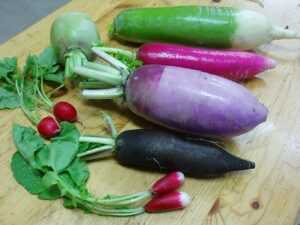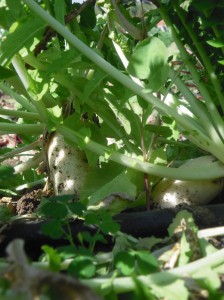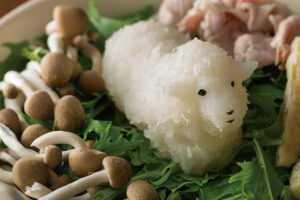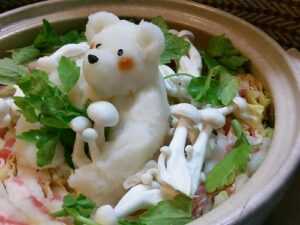Who Are You, Strange-Looking Vegetable?
Today’s riddle: what looks like a huge carrot, smells like a radish and has leaves like a turnip??
(And, yes! He’s been spotted of late in your Chubeza box!)
Well, ladies and gentlemen, the time has come to introduce you to the strange but extraordinary………(drumroll)………Mr. Daikon!
But who and what is he?
The daikon is a white elongated radish of Japanese origin. Contrary to popular belief, the radish is not a boring product at all, but rather a colorful, diversified vegetable ranging in size and shape from tiny cherry-like radishes all the way to huge basketball-sized models. The elongated radishes vary from small finger-sized varieties to whopper radishes measuring 60 cm long and 15 cm wide! And the radish color scale stretches from red and purple to different hues of pink, yellow and green, to white. There are even black (Spanish) radishes, with a black peel and white interior.
The Chinese, Egyptians, Greek and Romans have been well acquainted with radishes for thousands of years. In the Mediterranean area, we can track the presence of radishes back to 2,000 years BC, with the oldest illustration of a daikon (to date) appearing on the pyramid walls nearly 4,000 years ago! In ancient Greece, radishes were greatly revered, and golden radish icons were used to worship Apollo. In comparison, the beet came in second with silver icons, with turnips rating only the lead version. Roman lore includes mention of different-shaped radishes in various sizes: round and elongated, small and large. Most of the radishes of the time must have been jumbo size, similar to today’s Far East varieties. The small radishes were introduced to us from the middle of the 16thcentury. The radish is also one of the first crops introduced to the Native Americans by Columbus. Around the 1500s, it was already known in Mexico and Haiti. To this day, there is an interesting radish festival that takes place in southern Mexico during this time of the year.
In Israel, the radish was known during the Mishnaic Era. Its seeds were used to make oil for lamps, and it was grown for food. It was considered a delicacy that was served to kings and rulers all year long: “These are Antoninus and Rabbi, whose table never lacked radish, lettuce or cucumbers, neither in summer nor winter!” (Berachot, 41)
Such is the low-maintenance radish, which can be grown with relative ease throughout the entire year. It even tolerates the hot Israeli summer, although it prefers the coolness of winter, spring and autumn.
While Europeans are partial to the small, round reddish-pink radish, the East opted for the larger sizes, thus the species that developed there are the longer, paler types. The daikon is a Japanese white radish, as its name “big (dai) root (kon)” testifies. It looks a little like a big smooth, white carrot (but there are also yellowish, green and black varieties). Size-wise, daikon varieties run the full gamut from giant-size to small, depending on their specie and conditions of growth.
The daikon is especially adored in the Far East. It is renowned for its ability to aid digestion and purify and relieve the respiratory system. The daikon constitutes one-third of the vegetables grown in Egypt (by weight). These radishes are usually preserved in huge barrels and added to food as pickles. And to top it all – the daikon is simply tasty. Its flavor and texture are somewhere between the radish and turnip, with a bite that is milder than the radish and with a wintery freshness that only such a root can attain, which is why you might recognize it as that grated vegetable served with sushi, alongside the pickled ginger. There its aim is to “cleanse” your taste buds in between bites of sushi so as to maximize the full experience of each roll.
We make the most use of the radish root (or more accurately, the neck of the root), but in different areas in the world other parts are used as well. There are species grown solely to extract oil from the seeds, while others are developed for their leaves.
From the time of the Mishna, the radish has been known to aid digestion: “the radish cuts the food” (Avoda Zara, 11), and as a plant that reduces fever and aids in relieving the common cold. “The radish is good for those ailed by [lack of] sunshine” (Rashi, Avoda Zara, 28). These claims are supported today by the proven nutritional value of radishes and daikons, rich in vitamin C and enzymes that aid digestion, explaining the long tradition of their medicinal remedies.
In an article in praise of the daikon, Rebecca Wood, a guru of whole natural food, writes that the daikon purifies the blood, improves energy flow, accelerates metabolism, purifies the kidneys and cleanses the lungs. She suggests regular consumption of daikon to prevent the common cold, flu and respiratory infections. Wood touts daikon as a remedy for hangovers, sore throat, flu and edema, and even claims it’s a cancer-preventer. Click here for her personal daikon brew for treating asthma, bronchitis, the common cold, indigestion and even for dieting. Truly, a wonder vegetable.
Back to Chubeza, we know a daikon is ready to be harvested when it starts peeking out of earth. As this lanky vegetable matures, it grows so big that the space allotted for it in the earth becomes crowded. Thus it starts pushing out above ground, looking like this:
And now, for a little daikon comic relief: the beloved daikon lends itself brilliantly to food sculpting events where world-renowned chefs and laymen alike come to sculpt dinner. Here are some especially adorable daikon-made characters:
Tips for Storing Radishes and Daikon:
-To prevent radishes (and daikons) from becoming “dry as a radish,” they must be refrigerated. First, remove the leaves to prevent them from drawing moisture from the root. Afterwards, place the root in a plastic bag or sealed container in the refrigerator. – If, despite it all, the radish becomes shriveled and pathetic, place it in a bowl of ice water to revive the radish and restore its firm texture. – A Japanese secret for cooking daikon: use rinse water from rice, or a bit of rice vinegar, to retain the daikon’s whiteness and temper the bitter, sharp taste. – In cooking, peel the daikon to reduce the bitterness found primarily in the peeling and to prevent stringiness. The root itself is sweet and crunchy.
Check our recipe section for a host of delectable daikon recipes in a variety of delicious uses.
Go ahead and try them…Enjoy!! Wishing us all a great week, Alon, Bat Ami, Dror, Yochai and the Chubeza team
______________________________________
WHAT’S IN THIS WEEK’S BOXES?
Monday: Parsley/coriander, lettuce, fennel, cucumbers, cabbage/red cabbage, broccoli, tomatoes, carrots, celery/celeriac, daikon/kohlrabi. Small boxes only: scallions/leeks
Large box, in addition: Fresh onions, beets/snow peas/ fava beans, mesclun mix(“baby”)/arugula/mizuna, Jerusalem artichokes/ broccoli greens/kale.
Wednesday: Parsley/coriander, lettuce, cucumbers/peppers, green/red cabbage, broccoli/cauliflower, tomatoes, carrots, celery/celeriac, daikon/kohlrabi/white turnip, scallions/leeks/fresh onions, mesclun mix(“baby”)/arugula/mizuna.
Large box, in addition: Fennel/beets, snow peas/ fava beans, Jerusalem artichokes/ broccoli greens.
And there’s more! You can add to your basket a wide, delectable range of additional products from fine small producers: flour, fruits, sprouts, honey, dates, almonds, garbanzo beans, crackers, probiotic foods, dried fruits and leathers, olive oil, bakery products, apple juice, cider and jams, dates silan and healthy snacks and goat dairy too! You can learn more about each producer on the Chubeza website. On our order system there’s a detailed listing of the products and their cost, you can make an order online now!





